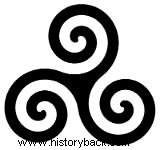The Celts are an ancient people who inhabited regions of Europe between the 2nd and 3rd centuries BC.
There were several peoples who shared the Celtic language and culture, and thus, they did not form a single people, living in different places and often being enemies with each other. This fragmentation was essential for the Romans to dominate them.
Celtic influence is still felt today through festivals such as Halloween; legends such as "Tristan and Isolde"; Irish folk music and languages such as Welsh and Gaelic.
Location of the Celts
 European regions where the Celts lived
European regions where the Celts lived
The Celts originate from the Central European region, and spread from the Iberian Peninsula to the Anatolian Peninsula.
They occupied locations in current countries:England, Scotland, Ireland, Wales, Spain, France, Germany, Belgium, Netherlands, Denmark, Austria, Czech Republic, Slovakia, etc.
Social organization
Celtic society was organized in tribes and very developed for the time, with a social, religious, political and economic organization.
There were several Celtic ethnic groups, including the Britons, Gauls, Belgians, Scots, Batavians, Eburons, Galatians, Trinovantes and Caledonians.
Each tribe, however, was organized through clans (families that shared land) and based on a hierarchical society. They were divided into:
- Nobles
- Free men
- Servants
- Craftsmen
- Slaves
In addition to them, the so-called "druids" were the priests who had great prestige in Celtic society.
See also:Barbarian PeoplesCeltic Economics
In the Celtic economy trade was practiced. They traded products with other peoples of antiquity. The agricultural techniques used by them were already very advanced for the time.
Celtic Culture
The language spoken by the Celts (Celtic language) was from the Indo-European language family. Since they are the first peoples to use iron in Europe, the Celts were considered the propellers of the Iron Age.
They were great lovers of the arts, especially crafts and music.
Learn more about the Age of Metals.
Celtic art
 Example of Celtic art
Example of Celtic art
Part of Celtic art is highlighted by craft objects. The metal was already used in the manufacture of various utensils, jewelry, sacred artifacts, weapons, armor, among others.
Interesting to note that they appreciated abstractionism (abstract art) expressed in various geometric and spiral-shaped designs.
Celtic sculpture had a religious character, as it was made to scare away evil spirits or honor the gods.
Celtic Music
Celtic music was performed by troubadours, druids, bards and dancers. It had a religious character and was usually accompanied by various instruments, such as flutes, bagpipes, harps.
Currently, this style is very popular in several European countries of Celtic origin as part of Irish and Scottish folk music. Today there are many Celtic music festivals around the world.
Celtic religion and mythology
The religion of the Celts was polytheistic, that is, they believed in several gods related to nature. For this reason, a lot of mysticism surrounds their beliefs.
They performed various ceremonies, feasts and rituals in honor of the gods and goddesses. In some ceremonies there were human sacrifices.
Druids presided over and conducted various rituals. Note that many Celtic gods had animal forms. Highlights:
- Mother Goddess:Goddess of Nature
- Tan Hill:God of Fire
- Tailtiu and Macha:Goddesses of Nature
- Epona:the goddess of horses
- Goibiniu:brewer god
Did You Know?
Many legends with Celtic elements survive, such as "King Arthur and the Knights of the Round Table" and "Tristan and Isolde".
Some fairy tales that we currently know are inspired by Celtic mythology, such as "Little Red Riding Hood". In the original story, she was the sun and the wolf was the night.
The Halloween party originates from a Celtic festival, Samhain.
See also:History of HalloweenCeltic Symbols
There are several symbols associated with Celtic culture. See below the most important ones and their meanings:
Celtic Cross :represents balance through the union between the four elements of nature and the feminine with the masculine.
 Celtic Cross
Celtic Cross
Triskle :represents the elements of nature and was used to evoke the gods.
 Triskle
Triskle
Celtic Knot :represents the eternity of life, so this node has no beginning or end.
 Celtic Knot
Celtic Knot
